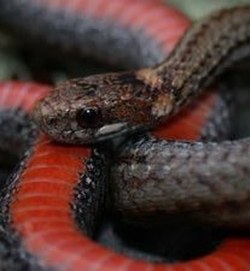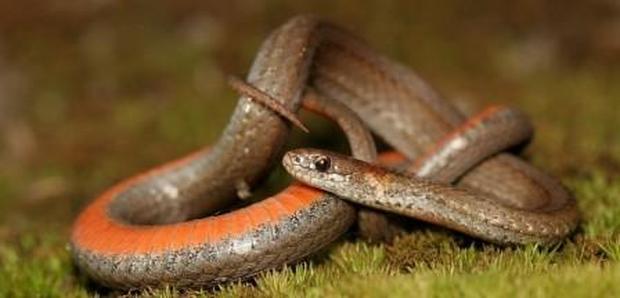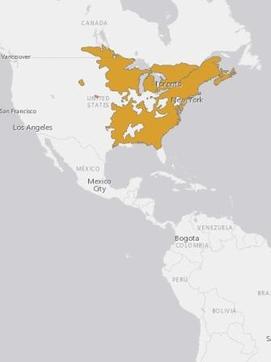Red-Bellied SnakeStoreria occipitomaculata |

Custom Search
|
|
The red-bellied snake or redbelly snake (Storeria occipitomaculata) is a non-venomous snake endemic to North America belonging to the Colubridae family. Its range extends from southern Canada (Saskatchewan, Nova Scotia) extending southward into the east regions of the United States as far south as central Florida and east to southeastern Texas and the Gulf Coast.
Other US states where these snakes can be found include Maine, Minnesota, Oklahoma, Kansas and North Dakota. One of its 3 subspecies are the isolated populations found in the Black Hills mountain range region in Wyoming and South Dakota. These snakes are also known other common names like the red-bellied snake, red-bellied ground snake, spot-necked snake, worm snake, ground snake, copper snake, brown snake, little brown snake, red-billed brown snake, red-bellied garter snake or fire snake. They can be found in a variety of habitats with abundant ground cover including mountainous or hilly woodlands or forests, upland meadows and valleys, marshes, prairies, pastures, wetlands, and swamp or bog edges. Generally found in the moistest areas of their habitat they can also inhabit dryer areas such as rocky hills anywhere from sea level up to 5600 ft (1,700 m) high. The redbelly snake is very secretive usually taking shelter under rocks, leaf litter, logs, bark, ant mounds but also in trash piles, abandoned houses, building foundations or coverboards and sometimes seen on roads in the open. Normally found hiding together or near other red-bellied snakes but also with other snake species such as the worm snake (genus Carphophis), rough earth snake (Virginia striatula) or the brown snake (Storeria dekayi).
The red-bellied snake as a length ranging from 7 or 8 up to 16 inches, while females are longer than males have a slightly longer tail. Their dorsal color varies from gray, brown, olive-brown, chestnut-brown, tan-brown, red-brown or even black.
The back coloration has different shades which form a striped pattern, sometimes only a wide light stripe is visible while on some individuals 4 narrower darker stripes may be found along the length of the back. Their common name comes from their distinct and unmarked bright red underside, but occasionally some specimens may have an orange, yellow, pink, crimson or on rare occasions a bluish or black belly. The top of the head is usually darker than the rest of the body, being black in most specimens. The chin and throat areas are usually white. Sometimes their distinct neck spots fuse to form a collar-like marking. Juveniles have a similar appearance to adult snakes but are normally darker with a less vivid underside coloration. This species has keeled scales, but lacks any loreal scales those located between the eyes and the nostrils. Red-bellied snakes become prey for a variety of other wild species such as ground squirrels, raccoons, shrews, hawks, largemouth bass but are also killed by domestic chickens, cats, and dogs. They are also preyed upon by other larger snake species like the southern black racers, milk snakes or king snakes. They usually live about 4 to 5 years. In the winter red-bellied snakes embark in a mass migration to find good hibernation sites such as abandoned burrows or anthills. They hibernate together in groups and sometimes even with other small snake species. These snakes are usually active during the day in spring and autumn in the during hot the summer months the redbelly snake become nocturnal. Their defensive behaviors when startled or feeling threatened include a strange lip-curling exposing their black mouth, flattening their body or discharging a musky secretion from their cloaca. They rarely bite but sometimes they feign death like other snakes such as the congeneric eastern hognose. Subspecies
The species-specific name occipitomaculata meaning spotted back of the head, refers to the 3 characteristic yellow or white spots usually found in their neck. The genus name Storeria was given in honor of the 18th-century zoologist from New England, David H. Storer. There are 3 subspecies currently recognized as being valid by scientists. The subspecies are named after the regions they inhabit. Northern redbelly snake (Storeria occipitomaculata occipitomaculata - Storer, 1839) - This subspecies has the widest range extending from southern Canada southward into the east regions of the United States as far south as southeastern Texas and the Gulf Coast. Florida redbelly snake (Storeria occipitomaculata obscura - Trapido, 1944) - As their name implies this subspecies is one of many snakes found in Florida, it's found in northern and central Florida but is absent from southern regions of peninsular Florida. In this subspecies their characteristic neck spots sometimes fuse forming a collar. Black Hills redbelly snake (Storeria occipitomaculata pahasapae - H.M. Smith, 1963) - This subspecies consists of an isolated population found in the Black Hills in western South Dakota and extending into Wyoming. Diet / Feeding The red-bellied snake diet consists mainly of slugs but they also feed on snails, beetle larvae, earthworms, other insects, and occasionally even small frogs or small salamanders. The species has some special adaptations to its teeth and jaws, which enables them to remove snails from their shell fairly easily. Often found in domestic gardens they are quite useful in controlling the numbers of harmful plant destroying animals. Reproduction The mating season occurs in the spring just after hibernation or the fall with females giving birth to live young, unlike most snakes that lay eggs. Females can store the male sperm for several months delaying fertilization over the winter until the spring arrives. They give birth in the summer form July or August to early September. The litter size varies but on average ranges between 4 and 9 younglings, but can be as high as 23 young snakes. When born the babies are covered by a rather thin membrane which they break very quickly. Juveniles are covered in a uniform black color with 3 cream to yellow spots on the neck and are between 7 and 11 cm long. The species probably reaches sexual maturity at 3 years of age. Conservation / Threats Red-bellied snakes are classified as a Least Concern species on the IUCN Red List, due to their wide distribution with several subpopulations, and their presumed large and stable population numbers. The species also occurs in many protected areas with no major threats known to affect them substantially. The red-bellied snake is also somewhat tolerant to minor habitat modifications.
|
Scientific classification |
© 2014 Snake Facts About Us | Privacy Policy | Contact





